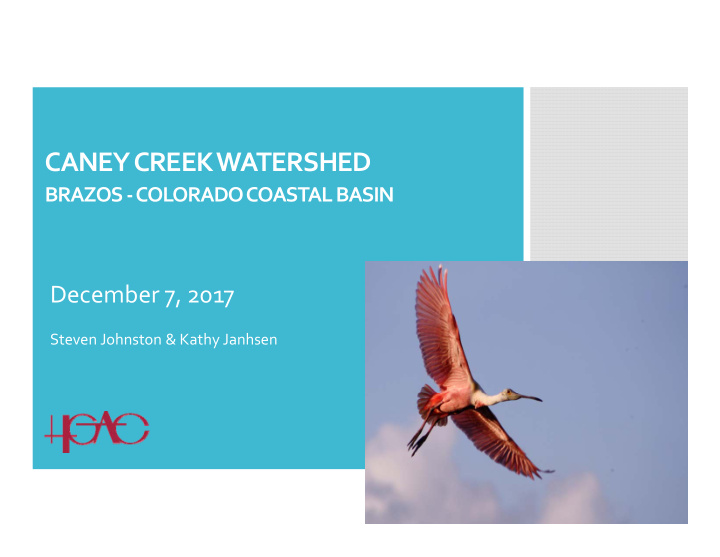



CANEY CREEK WATERSHED BRAZOS ‐ COLORADO COASTAL BASIN December 7, 2017 Steven Johnston & Kathy Janhsen
10:00 – 10:05 Welcome ‐ Open Meeting 10:05 – 10:25 Basin Approach Review Meeting 10:25 – 10:45 Caney Creek Special Study Agenda 10:45 – 11:30 Coordination Committee Discussion 11:30 – 12:00 Q&A / Meet and Greet
Share Basin Water Quality – Bacteria Review Water Quality Data What Are Potential Sources Meeting Watershed Planning Tools Goals Initiate Creek Stakeholder Involvement in Decisions Caney Creek Watershed Planning
Clean Rivers Program ‐ Region
Professional Monitoring 8 local partners • + TCEQ • + USGS • Regional Over 370 sites • Coordinated Monitored at least quarterly • Data quality ‐ assured Monitoring • Stream Team Monitoring 106 Volunteers • 92 Sites •
Why Are We Here?
BASIN CHARACTERIZATION REPORT FOR THE BRAZOS – COLORADO COASTAL BASIN FOR INDICATOR BACTERIA Segments: 1301, 1302, 1304, 1305 Basin 13 June 30, 2017
Bacteria
Bacteria Trends in Basin 13
Watershed Planning Tools include: Increase or Expand Monitoring Recreation Use Attainability Analysis (RUAA) Watershed Based Plans Total Maximum Daily Load (TMDL) and Implementation Plan (I ‐ Plan) Addressing Watershed Protection Plan (WPP) Impaired Galveston Bay Coalition of Watersheds Waterways
TMDL Study “Budget” for pollutant Focus only on constituent of concern Can lead to mandatory and voluntary changes Implementation Plan Watershed ‐ Determines HOW reductions will be made based Plans Based on stakeholder recommendations
TMDL Projects with I ‐ Plans
Watershed Protection Plans Voluntary approach to reducing impairments in Watershed ‐ local waterways based Plans Most funded under EPA CWA 319(h) grants from TCEQ, TSSWCB (cont.) Engage local stakeholders to use good science to generate solutions Target one or more issues, not only water quality
Regional WPP Projects
Caney Creek Special Study
Bacteria Trends Most Standard Geometric Earliest Number of Segment Recent Indicator (MPN/ Mean (MPN/ Data Results Data 100 mL) 100 mL) Caney Creek 1/28/2010 10/13/2016 27 e. coli 126.00 155.5 Above Tidal Caney Creek 1/28/2010 10/20/2016 36 enterococci 35.00 55.1 Tidal
Basin Data
Caney Creek: Land Cover
Caney Creek: OSSF
Caney Creek: WWTF Outfalls
Agriculture Household Pets Feral Hogs Other Wildlife Other Potential Sources
Load Duration Curves
TMDL = WLA + LA + FG + MOS Example: Chocolate Bayou TMDL – (Preliminary) TMDL MOS WLA wwtf WLA sw LA Watershed Segment (Billion (Billion (Billion (Billion (Billion MPN/day) MPN/day) MPN/day) MPN/day) MPN/day) TMDL Chocolate 1107 718.01 21.08 44.72 18.46 633.75 Bayou Tidal Chocolate Bayou 1108 1,334.80 66.74 142.63 57.96 1,067.47 Above Tidal
What’s a Coordination Committee? A proactive group of local and regional stakeholders helping to create and drive content for the TMDL / I ‐ Plan and/or WPP documents. Basin 13 Meeting – Caney Creek | December 7, 2017
Role of the Coordination Committee • Attend Public Meetings • Provide Input of Priorities for the Watershed • Participate in Work Groups • Identify Appropriate Existing Measures • Act as Community Ambassadors • Provide Input on Documents & Reports Basin 13 Meeting – Caney Creek | December 7, 2017
What are Existing Measures? Existing measures are a menu of voluntary strategies stakeholders can use to reduce bacteria levels in Caney Creek. Basin 13 Meeting – Caney Creek | December 7, 2017
Small Group Discussion (1) POTENTIAL INTERESTS (2) NUMBER OF REPRESENTATIVES • Citizens • Parks / Recreation • Ideal size of the committee? • Education • Resource Agency • Other committees range from 31 members to 18. • Environmental Groups • Watersheds • Number should be fairly distributed by interest. • Government Interest • Wildcard • Industry and Business • Others? (3) PROCESS TYPES (4) MISSING PIECES FORMAL INFORMAL • Who should be here that isn’t? • Formal nominations • Informal nominations • Are we missing major industry or stakeholder • Recorded votes • Consensus ‐ based groups? • Written rules of order • Ground rules Basin 13 Meeting – Caney Creek | December 7, 2017
Small Group Discussion ‐ Results 1. Return to Larger Group 2. Review Results of break ‐ out session i. Interests to be represented ii. Appropriate committee size iii. Preferred process type iv. Missing people & pieces? 3. Group Discussion of Results 4. Next Steps Basin 13 Meeting – Caney Creek | December 7, 2017
Do Watershed Plans Work?
Texas Stream Team Training – Spring 2017 Implementation: Workshops and Training Texas Watershed Stewards Training/July 11, 2017
Questions?
Recommend
More recommend